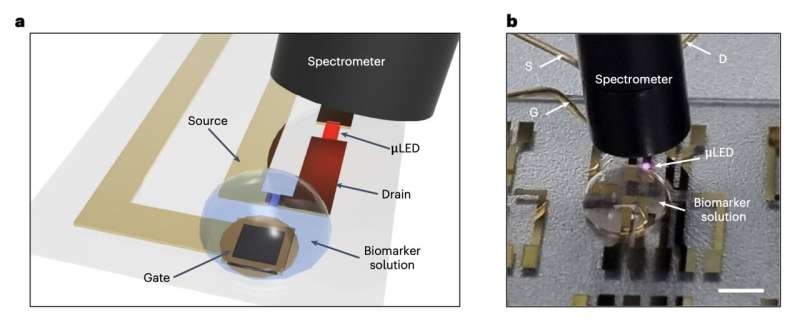Ultrathin organic-inorganic device shows promise for wireless monitoring of biomarkers
In recent years, electronics engineers have developed a wide range of wearable and implantable devices that can detect and record biological signals. These devices can help to keep track of various physiological processes, such as heart rate, arterial pulse, sleep patterns or calories burned throughout the course of the day, which can be valuable for both sports and health care-related applications.
Organic electrochemical transistors (OECTs), electronic components based on flexible organic materials that can amplify biological signals, have proven promising for developing wearable technologies that monitor subtler health related signals. For instance, these flexible transistors could pick up information about glucose, lactate, cortisol and pH levels, as well as neurotransmitters and metabolites, which could be highly beneficial for diagnosing or monitoring specific medical conditions.
Despite the advantages of OECTs, the data they collect must then also be transmitted to external devices, which entails the use of wireless communication circuits. These circuits are typically based on inorganic and rigid materials, which can increase the size and thickness of devices, while reducing their mechanical flexibility.
Researchers at the Korea Institute of Science and Technology (KIST) recently developed a new wireless device that can monitor various biomarkers, including glucose, lactate and pH levels. This device, presented in a paper in Nature Electronics, effectively integrates components based on organic and inorganic materials, resulting in good performance and excellent mechanical stability, with an overall thickness of 4 μm.
“We report an ultrathin organic–inorganic device for wireless optical monitoring of biomarkers, such as glucose in sweat and glucose, lactate and pH in phosphate-buffered saline,” Kyung Yeun Kim, Joohyuk Kang and their colleagues wrote in their paper. “The conformable system integrates an organic electrochemical transistor and a near-infrared inorganic micro-light-emitting diode on a thin parylene substrate.”
The device developed by Kim, Kang and their colleagues consists of OECT biochemical sensors integrated with inorganic micro-light-emitting diodes (μLEDs). The team fabricated the OECT sensors by patterning gold electrodes and a polymer mixture of two ionomers (PEDOT:PSS) on an ultrathin parylene substrate.
The sensor was then connected to the μLEDs based on inorganic materials. The OECTs can detect specific biomarkers, as the current flowing through them changes depending on the concentration of these biomarkers in the sensors’ surroundings. Changes in the OECT channel current in turn modulate the light irradiating from the μLED, allowing the wearable device to monitor the biomarkers.
“The channel current of the transistor changes according to the biomarker concentration, which alters the irradiance from the light-emitting diode to enable biomarker monitoring,” wrote Kim, Kang and their colleagues. “We combine the device with an elastomeric battery circuit to create a wearable patch. We also show that the system can be used for near-infrared image analysis.”
In initial tests, the 4 μm-thick device for biomarker monitoring attained very promising results, exhibiting a high transconductance (gm) of 15 mS and excellent mechanical stability. The team found that the device could also be used to analyze near-infrared images and to predict the concentration of glucose, lactate and pH from these images.
In the future, the new device could be tested and improved further, potentially contributing to the development of new medical technologies. The device could also be adapted so that it is powered by soft batteries or solar cells, which would result in a fully chipless sensing system.
More information:
Kyung Yeun Kim et al, An ultrathin organic–inorganic integrated device for optical biomarker monitoring, Nature Electronics (2024). DOI: 10.1038/s41928-024-01237-6
© 2024 Science X Network
Citation:
Ultrathin organic-inorganic device shows promise for wireless monitoring of biomarkers (2024, September 20)
retrieved 21 September 2024
from https://techxplore.com/news/2024-09-ultrathin-inorganic-device-wireless-biomarkers.html
This document is subject to copyright. Apart from any fair dealing for the purpose of private study or research, no
part may be reproduced without the written permission. The content is provided for information purposes only.

Comments are closed